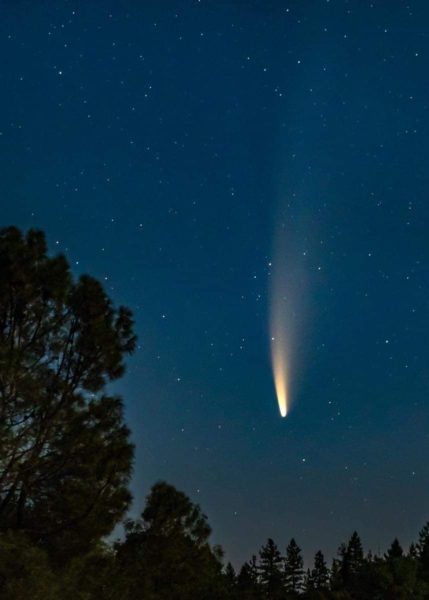Comet NEOWISE
Comet C/2020 F3 (NEOWISE) survived a close pass (within the orbit of Mercury) with the Sun over the 4th of July weekend. It is bright enough for the unaided eye. Its long tail looks even better in binoculars.
The comet is visible while it is above the horizon and the Sun is sufficiently below the horizon to darken the sky enough to see the dim comet. This is before nautical dawn or after nautical dusk when the Sun is 12º below the horizon.
The comet rises in the northeast two hours before the Sun and sets with the Sun around 8:30 p.m. Look for a point of light with a fuzzy tail extending up and slightly to the left. Comet tails point away from the Sun.
The best time to look in Alabama this weekend is just before 4:00 am when it is very low on the horizon and 4:45 a.m. The earlier you look, and darker your skies the brighter the comet will be. The clearer your northeastern horizon, the earlier you can look.
As the comet continues to travel away from the Sun, it will become more visible in the evening, low on the northwestern horizon. Don’t delay in seeing it though, it is also expected to dim significantly over the coming week.
| date | morning low on NE horizon |
evening low on NW horizon |
|---|---|---|
| 7/11 | 3:51 AM – 4:32 AM reaches 5.4° above horizon |
not visible |
| 7/12 | 3:51 AM – 4:26 AM reaches 4.4° above horizon |
not visible |
| 7/13 | 3:53 AM – 4:21 AM reaches 3.3° above horizon |
9:26 PM – 9:36 PM appears 1.0° above horizon |
| 7/14 | 3:57 AM – 4:15 AM reaches 2.0° above horizon |
9:31 PM – 9:56 PM appears 2.6° above horizon |
| 7/15 | 4:04 AM – 4:10 AM reaches 0.7° above horizon |
9:37 PM – 10:17 PM appears 4.2° above horizon |
| 7/16 | not visible | 9:43 PM – 10:37 PM appears 5.7° above horizon |
| 7/17 | not visible | 9:49 PM – 10:56 PM appears 7.1° above horizon |
Category: ALL POSTS, Spacey Stuff



















